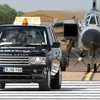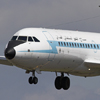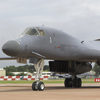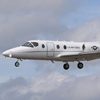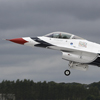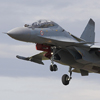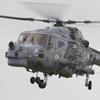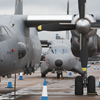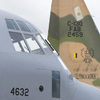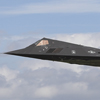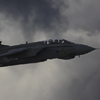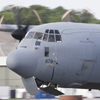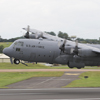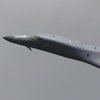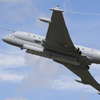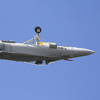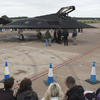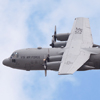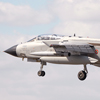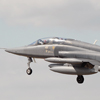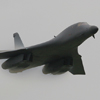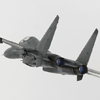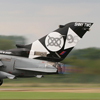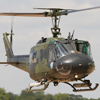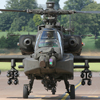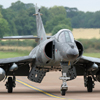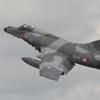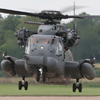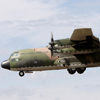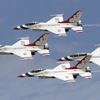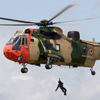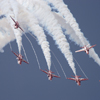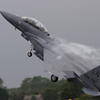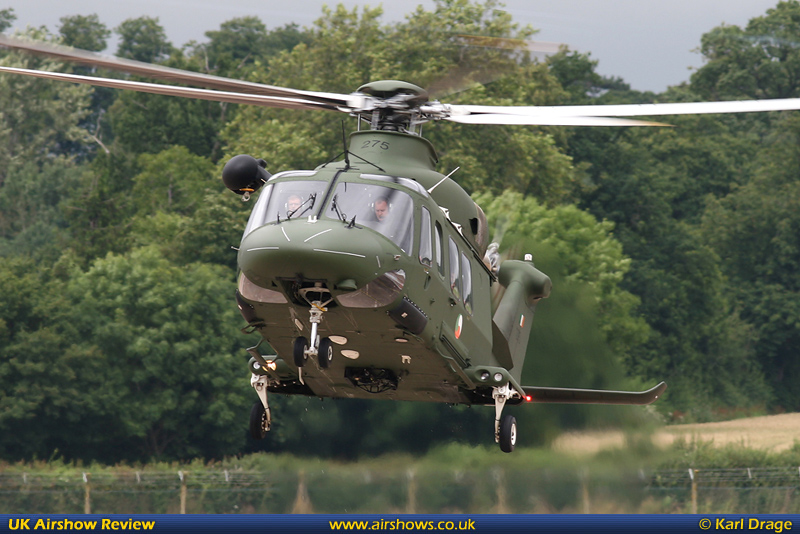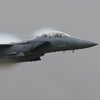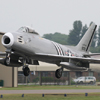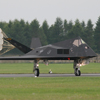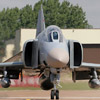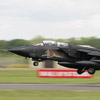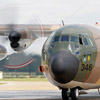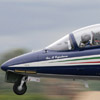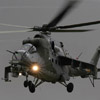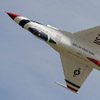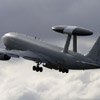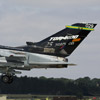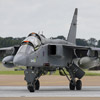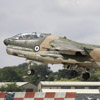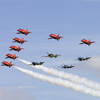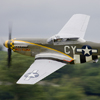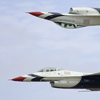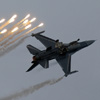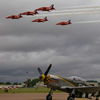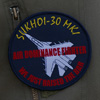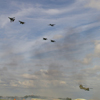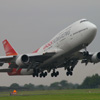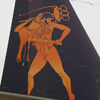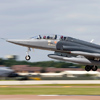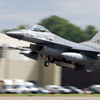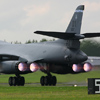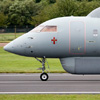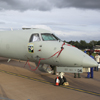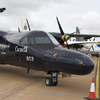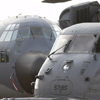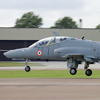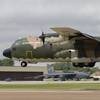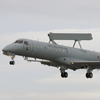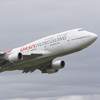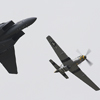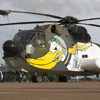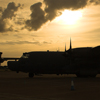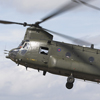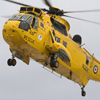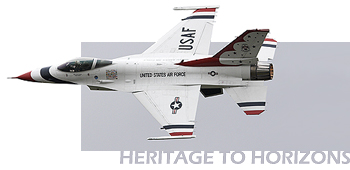
Royal International Air Tattoo 2007 Review
Tuesday 10th July - Monday 16th July
More than 320 aircraft from 24 countries and 37 air arms converged on the annual aviation nexus that is the World's biggest military airshow, the Royal International Air Tattoo. Despite predictions of a washout the much feared rain that had blighted Waddington just two weeks prior never did fully materialise and a gem-filled Fairford remained, for the most part, mercifully dry drawing in crowds in the region of 170,000.
reflects on a week spent in the meteorologically mixed Cotswolds. Photography from the .
Royal IAT Twenty Oh-Seven began a day early this year, to many people's chagrin, as Tuesday saw the much-anticipated arrival of the United States Air Force Aerial Demonstration team, the Thunderbirds. First to arrive was Thunderbird 14, one of the team's C-17A Globemaster III support aircraft hailing from McChord AFB, followed some 15 minutes later by the Thunderbirds proper. In formation and with smoke on the six F-16Cs followed by the two Delta models of the demonstration team announced their arrival to the UK after a six year absence. An opportunity was taken to familiarise themselves with the surroundings preceding the team finally touching down on British soil, or more accurately American tarmac. Not to be outdone by its fighter cousins Thunderbird 15, in the form of a 60th Air Mobility Wing Globemaster from Travis AFB, rocked her wing for the assembled enthusiasts, carrying on down runway 27 at low level before pulling up into a steep bank at the opposite end reminding those there of the old displays, sadly not seen for some time. Alongside this the Tuesday saw the arrival of a pair of F-117A Nighthawks from Holloman AFB, who each performed a go-around before landing, as well as a rare Wisconsin ANG KC-135R and a McGuire AFB based KC-10A. A not bad start considering the show week hadn't even started.
The first "official" arrivals day began as a cloudy affair for those waiting in line at silly o'clock for the Park & Views, but hope remained as the clouds appeared patchy and sure enough before the gates opened a ray of sunshine, almost biblically, peered through the clouds onto those waiting below. The majority of the German contingent turned up on the Wednesday as well as the ever-dependable Jordanian Falcons and Royal Jordanian Air Force C-130H "Guts Airline" from 3 Sqn. A wonderful surprise came in the movements list in the form of a pair of 156 Gruppo, 36 Stormo Tornado PA2000 IDSs of the Italian Air Force. These aircraft had not been on the participation list so it was a real treat to watch them on finals, even more so as one of the examples was sporting an all over black colour scheme, including wildcat artwork, to celebrate 60,000 flight hours. Other highlights destined for the static included the rarer than hen's teeth Royal Air Force of Oman BAC 1-11, soon to be replaced by the less charismatic A320, and the Turkish NF-5A/B-2000 pair from 133 Filo who each performed 2 missed approaches to the delight of the photographers, before landing.
The clag of Thursday was offset by the variety of aircraft on offer. From Hercs to Hogs, BUFF to SLUFF, Bone to Bolkow, Lynx to Lancer and Hornet to Hunter, the Thursday had it all and even the odd rehearsal thrown in for good measure too. Special tail schemes were seen in abundance celebrating 10,000 hours on the Czech L-159, Hercules and his legacy, unsurprisingly, on the Greek C-130 and the 95th anniversary of No. 2[AC] Sqn "The Shiny Two" RAF, to name but a few. A less than lazy lunch was provided by the Thunderbirds who performed a practice display and stunned onlookers by debriefing in the air before redoing individual manoeuvres. Practice displays by European teams seem a mere formality to get the green tick from the Flying Control Committee so to see a demonstration team in the middle of its display season actually practicing during a practice display was a somewhat new experience, although in fairness to the Thunderbirds they were flying an aircraft short and to a display that had to be altered to meet CAA requirements.
With the Thunderbirds back on the ground the afternoon saw some noteworthy arrivals; the Hungarian Gripen popping its RIAT cherry, the aforementioned special tails, the near extinct Jaguar - a T2 variant from QinetiQ, the first visit to the UK of a T-1A Jayhawk, heavy metal in the shape of the behemoth that is the Indian Il-78MKI Midas, the Canadian CT-142 Gonzo and a welcome return of the Czech Hip and Hind, all of which, with the exception of the Hind, would be available for closer inspection in the static park. The last movement of the day for many came when a formation of three Flankers loomed into sight around teatime, two of which landed leaving the third to perform a short display validation before heading off to Waddington. Short and sweet but well worth the wait.
As per usual the final arrivals day saw the majority of UK plc arrive as well as one of the Irish Air Corps new AW139s for the static. A No. 5[AC] Sqn Sentinel R1 made its debut at RIAT arriving for the static and the Empire Test Pilots School's new Agusta 109 Power, resplendent in house colours, popped in briefly. Conditions were really quite dreich but despite this rehearsal after rehearsal took place, a testament to the crews given the murkiness of the day. Around 1pm the eastern half of the static was opened up for the FRIATers. However, a mere hour later the rain came halting play for many and forcing those roaming the static to seek shelter wherever an umbrella (or Hercules wing!) would allow.
One of the show's main themes this year was the USAF 60th anniversary. This milestone was marked with the flying display around about midday being dedicated to USAF aircraft past and present. Three generations of fighters could be seen with displays from the F-86A Sabre, F-15E Demo Team's Strike Eagle and P-51D "Miss Velma", in the capable hands of Ed Shipley, during the heritage flight. Golden Apple Operations gave an enjoyable display showing off their Korean War classic whilst Captain Albert "Jewel" Kennedy and his WSO Captain Jack "Woody" Stallworth showcased the Strike Eagle's tactical abilities with a liberal sprinkling of vapour, reheat and topsides. This was followed up by the Heritage Flight that saw a few passes and a break from "Miss Velma" and the Mudhen. The Heritage Flight is always a welcome addition to any show, even if the accompanying music is a bit naff, but it's a shame that with a Sabre already in the display that it couldn't have been incorporated in, even just for a single pass.
Car alarms wailed in protest as the usual subjects, B-1B and B-52H (Sunday only), took off for their all too predictable flypasts. This year, however, something looked different as the Bone took a different line on her run in. Approaching the airfield from behind the display line with full sweep she dropped a wing and proceeded to bank in front of the crowd, coughing up a most refreshing topside to a rapturous applause of shutter cycles. As well as a high-speed pass, those attending on the Saturday got to see this long range penetration bomber perform a derry turn and, instead of the usual long final, a fighter style break into the circuit to land. If the crew of "Hellcat" came into the FRIAT enclosure they would be worshipped as Gods and would probably still have too much alcohol in their system to fly home now!
Just as 2005's RIAT saw its last Sea Harrier and 2006 its last Canberra, this year's show featured what is more than likely, the F-117A Nighthawk's final UK appearance. The display from the Wobblin' Goblin only consisted of a few straight level passes and a rather distant topside but this was made up for by a low go around offering the only real photographic opportunity of the display. That said a final chance to see this engineering triumph was not to be scoffed at. After 25 years the product of Have Blue is retiring from service, still looking as futuristic as the day it entered it.
Taking pride of place in the USAF 60th anniversary celebrations were the United States Air Force Aerial Demonstration Team, the Thunderbirds. Despite reservations accumulated after watching the practice display, the team showed just how good they could be on the show days. While not as dynamic as European teams are, in terms of changing formations in front of the crowd and ensuring something is always happening, their display was not the fragmented assortment of formations that had been feared, and instead flowed well. The formations were tight, close to the crowd and the speed that they were carried out at was equal or faster than we are used to seeing. The airmanship of the team was no better displayed than by the high alpha pass and max rate turn, including afterburner, performed by the "Lead Solo" Major Ed Casey. A slower high alpha or tighter turn in a display you will not see; an exceptional piece of flying. The Thunderbirds also brought across manoeuvres not currently seen in the British airshow circuit, for example when's the last time you saw a four-ship twinkle roll, an aircraft perform an aileron roll straight after take-off or a formation split into two pairs separated (one high and one low) to allow a fifth aircraft to scream through the recently created void? The inclusion of sneak passes, another rarity in the UK scene, ensured that the crowd were kept on their toes and gave the display a good balance between high and low speed. Credit is also due to the team as they made the effort to tailor their music for a non-American audience, which ensured that those watching the display were able to do so without wincing at what is known over here as "patriotic tripe". Had they been allowed to perform their full routine with a pair approaching from crowd rear, splitting along the crowd line and having the aircraft converging from all angles at display centre in the "Bomb-burst Cross", amongst other manoeuvres, then there would have been no doubt to the team's skill and entertainment value. Even with the UK airshow flight safety limits dictating their display to them, the Thunderbirds still proved themselves to be one of the premier display teams and were an excellent addition to the flying display.
Once again the 18[B] Sqn Chinook HC2 put on a stunning audio and visual feast for the crowds. No matter how many times you see it, the 270° quickstop never fails to amaze as 51ft of wokka decelerates rapidly whilst pivoting around its nose so that in the blink of an eye you've gone from side-on to head to head with 10 tonnes of tandem rotor support helicopter.
Further rotary action could be seen from displays by the Czech Hind of 231 VrLt, the Royal Navy's Black Cats duo, a Sea King Mk48 of the Belgian Air Component and the Army Air Corps Blue Eagles. Eastern European aircraft are always welcome at the Air Tattoo so securing the Mil Mi-24V for the second year on the trot was a fantastic achievement and well worth it for the sight of the 'flying crocodile' prowling the skies of Fairford. The Sea King of 40 Smaldeel, looking stunning in a mixture of camouflage and day-glow panels, put on a Search and Rescue display for the audience, depositing and recovering a crewman via its winch. The Black Cats, both performing in HMA Mk8s, put on their usual precision display, dancing around each other at crowd centre and the Blue Eagles with back flips, barrels rolls and the rather tasty addition of a half Cuban Eight entertained the crowds also.
There were a few displays this year that were unique to a specific show day, namely the BAE Systems Nimrod MRA4 and IAF Su-30MKI on the Saturday and the Oasis Airlines 747-400 on the Sunday. The Nimrod performed three passes; one clean with FLIR on show, one with the bomb bay open and a dirty pass before throttling up and climbing into the distance. It was quite bizarre watching the Nimrod depart, as the new version is extremely quiet and there was a distinct lack of smoke that we tend to associate with "The Mighty Hunter" - surely shome mishtake? Like the Nimrod the Oasis 744 also performed three passes in various configurations, gracefully lumbering through the sky as a whale slowly glides through the sea. Unlike the MRA4, however, she came in to land, to leave later that day. The Flankers appearance can't really be called a display or a demonstration as it only took a minute, literally, and consisted of two turns, roughly over Worcestershire. It was one minute's worth more of Flanker than we could have got, but surely it could have performed a roller or even flown down the display line just once?
Display types could be seen in duplicate, as this year's show featured not only a pair of Typhoons but also pairs of Hornets and Fighting Falcons. The Spanish Tifon seemed to pack less punch than last year but that may be because the RAF example continues to improve. Flt Lt Jim Walls impressed the crowd with a display that started off with a photographer pleasing topside, reminiscent of the last pass of the old F3 display and continued with a performance demonstrating his aircraft's agility. Small touches to the display, such as an aileron roll in the distance instead of just straight level flight ensured that the RAF Typhoon, deservedly, won the FRIAT awarded "As the Crow Flies" trophy and the "Sir Douglas Bader" trophy for "Best Individual Flying Demonstration". The 29[R] Sqn display never fails to improve so let's hope next year to see it bigger and better than ever; rollers and AAR probe on display anyone?
F-16s were on display from European neighbours the Netherlands and Belgium, both of which put on smokewinder, reheat and flare laden shows. The Swiss F-18C of Fliegerstaffel 18 put on the usual excellent display, which seemed both closer and further away from the crowdline throughout its duration. Nevertheless it was an excellent display that won Capt Thomas 'Pipo' Peier the Paul Bowen Solo Trophy. Not to be outdone Capt Tommi Heikkala also flying an F-18C but that of HavLLv 11, Finnish Air Force took to the skies in equally impressive fashion winning the Lockheed Martin Cannestra Trophy for Best Overseas Flying Demonstration.
The Battle of Britain Memorial Flight, celebrating its 50th anniversary, had five aircraft participating in this years show; the Avro Lancaster, three Supermarine Spitfire PRXIXs and a Hawker Hurricane IIc. The tail chase offered an excellent opportunity to sit back and relax to the sound of Griffons and Merlins and the sight of the Lancaster, as always, was a captivating one. It's a shame that in the BBMF's 50th year that they could not get all the aircraft together for a few passes though.
The static park was full of lovely gems this year including the RAFO BAC 1-11, QinetiQ Jaguar T2, Flankers and Midas of the IAF, a pair of Italian HH-3F Pelicans, a T-1A Jayhawk of 99th FTS/12thFTW, AETC and a HC-130P of the 39th RQS, both of which were over for the USAF 60th celebrations. Despite this the one word to describe the static would have to be "clutterific!" Not strictly a word I know, but it does convey the atmosphere accurately. Cancellations happen, it's a fact of life, but with so many large aircraft confirmed not attending the show (RAF VC-10 and Nimrod MR2, NATO E-3A, Pakistani Navy P-3C, USAFE KC-135R to name but a few) as well as many other smaller aircraft being a no-show it was baffling to see what aircraft there were with cones right next to them and red "What aircraft is this?" ones all but underneath them, whilst elsewhere there were huge gaps with no aircraft in them. It was a real shame to see, in the vast expanse of Fairford, aircraft like the Jaguar crammed in like museum exhibits or the rare Canadian CT-142 with an ice cream van all but parked on its nose. It is nice to get close to these aircraft but it is possible to get a balance between getting the public close enough and giving the photographers enough space, sadly this year it was not found. One notable exception to this was the IAF aircraft, the Il-78MKI stood flanked on either side by the Su-30MKIs with plenty of space for the photographers to shoot from - when the canopy covers came off that is. One of the F-117As made it over from the north side of the airfield on both days to give the public a great chance to see this aircraft up close. It was annoying though that photography of this soon to be retired aircraft was restricted to a height no higher than could be reached on a set of step ladders.
Trainer aircraft displays, under the guise of the "Agile, Adaptable and Capable" theme, could be seen in the form of the FAF Alphajet which included an obscene angle of bank on take-off, a 208[R] Hawk T1A, the return of the Czech Air Force Aero Vodochody L-159 ALCA, Dutch Pilatus PC-7 and Alan Wade, whose crisp display of aerobatics, in his Slingsby Firefly, has become a regular and not undeserving feature of the show.
The RAF Role Demo was out for its fifth and final display of the season at RIAT and amazed the masses with its eclectic mix of rotor slap, jet noise and crowd warming pyrotechnics. Hopefully the success of this act will see it awarded more assets next year as in a display like this the impact rises exponentially with aircraft addition; a second Hercules and a few more helicopters would do nicely - especially at a large venue like Fairford.
The Patrulla Aguila who took to the sky in their much underpowered CASA C-101EB Aviojets brought the weekend to a close with an admirable performance, bearing in mind the horrid conditions in which they did it.
There was another type for which this show was to be its last outing; the commentator. After countless years Sean Maffet, the Voice of RIAT, is handing over the reins to an, as yet, unannounced successor. To many people, half of the RIAT experience is listening to Sean's commentary and it will be a very strange show next year without him.
The sun greeted those who awoke on the Monday morning and although its participation as the day wore on would become sporadic, the sheer number and variety of movements never fails to make departures enjoyable. A Belgian Air Component F-16AM leaving at just prior to 9am kicked off a day that saw some good and some not so good departures. The first aircraft of Triplex formation had already settled itself into a lower earth orbit by the time it had reached the FRIAT enclosure. Those at the western end of the airfield probably only heard what sounded like distant thunder or caught a fleeting glimpse of a flash as the sun caught it as it rocketed on past escape velocity. Well fair play to him, it was an impressive demonstration of the aircraft's power and control and the second Typhoon was still patiently waiting its turn to please the photographers. "Oh no you didn't", went out the cries as moments later the aforementioned pilot decided that, actually, he quite fancied a stab at being and astronaut too. One of a pair going all Yuri Gagarin is acceptable but two is soul destroying. A virtual carbon copy of this display occurred later in the day courtesy of the Indian Air Force Su-30MKI Flankers, the only difference, apart from looking a heck of a lot more menacing, being the blue glow in the stratosphere compared to the yellow one of Triplex. Recompense could, however, be drawn from the fact that the Flankers backtracked into position for take-off allowing those in FRIAT a good look at one of the stars of the show before they headed home, a nice touch by ATC. The vast majority of aircraft performed regular departures and a mood was expressed that the Monday was becoming less worth doing. However, a few pilots stuck their heads above the parapets and held high the flag of "non-standard departures", and as such they have earned a mention in dispatches. They are in no particular order; the crew of Luftwaffe Tornado 46+44 who with a drop of the left wing and a bootful of right rudder skewed their aircraft down the runway, the 17 Flotille Super Etendards who offered a rear topside as they climbed after the Friends of RIAT enclosure, the crew of the Ramstein Hercules for keeping it low and presenting a topside - pretty nifty for something the size of a '130. Those down at the western end were treated by the Spangdahlem A-10s who stayed low and offered up a wing waggle and by the MH-53M Pave Low IV that gave a sharp nose down before accelerating away into the distance.
Disappointingly for many the Thunderbirds and Stealth Fighters, both of which arrived a day early, were not to leave on the Monday. If two suggestions could be made regarding departures they would be that if time permits, to ask the helicopters to fly down the runway for all to see, and for the rarer items to perform a flypast before leaving. It can never hurt to see these potentially once in a lifetime sights just one time more.
RIAT Twenty Oh-Seven was a show of anniversaries: USAF 60th, BBMF 50th, AAC 50th and IAF 75th. Whilst the Indians can be forgiven for their attendance being that of the aircraft that were already deployed to the country, the USAF 60th anniversary theme seemed to be in name only. The static had some excellent rare American participants but at the same time it had just a sole Lakenheath based Strike Eagle. Where were the F-15C and HH-60G from the same base and the 100 ARW Stratotanker from a few miles beyond that? You'd be forgiven for thinking that they might have made the 100 mile, give or take, flight. The USAF segment of the flying display had the potential for some real highlights to celebrate 60 years since the formation of an independent US Air Force. The F-117A, B-52H and B-1B, all of which were in the air at the same time, could have formated for a flypast or flown past in a stream and a unique flypast with the Thunderbirds and the Red Arrows (or any other aircraft) could have cemented the flying display. We didn't even get a flypast of F-15s or A-10s. What we got instead, unfortunately, was just a series of [good] displays from American aircraft. The AAC's lack of participation was a shame seeing as this was their Golden Jubilee year and the RAF participation in the static was truly woeful, a sign unfortunately of British forces being stretched to capacity. Let's hope next year for the RAF's 90th that a few more types will be on display.
While the weather tried to put a dampener on this year's show, the excellent flying and variety shone through making it a good one, but not one without some room for improvement.

